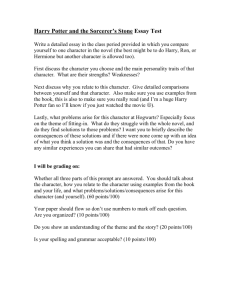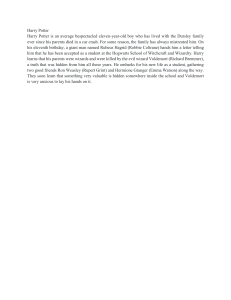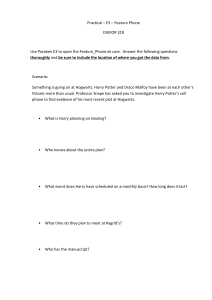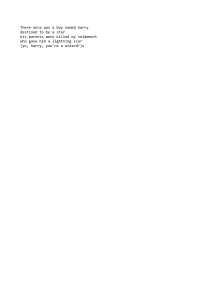The Magic of a Good Book Voluntary Fiction Reading Habits and Preferences of Adolescents
advertisement
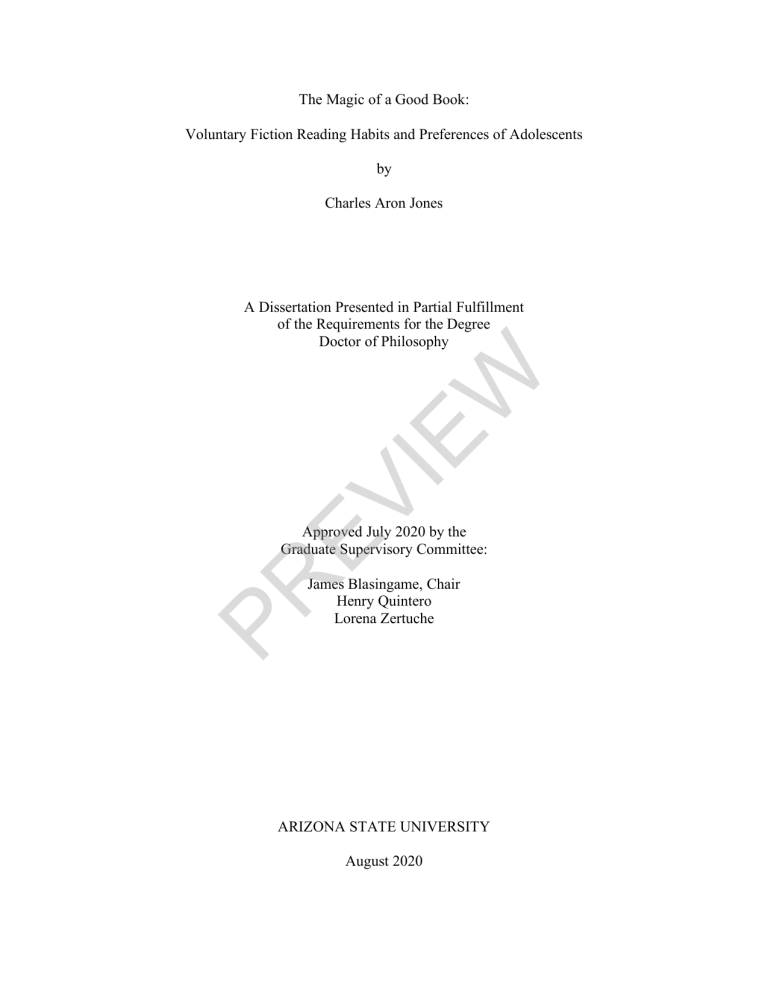
The Magic of a Good Book: Voluntary Fiction Reading Habits and Preferences of Adolescents by Charles Aron Jones EV IE W A Dissertation Presented in Partial Fulfillment of the Requirements for the Degree Doctor of Philosophy Approved July 2020 by the Graduate Supervisory Committee: PR James Blasingame, Chair Henry Quintero Lorena Zertuche ARIZONA STATE UNIVERSITY August 2020 ProQuest Number: 28028994 All rights reserved INFORMATION TO ALL USERS The quality of this reproduction is dependent on the quality of the copy submitted. EV IE W In the unlikely event that the author did not send a complete manuscript and there are missing pages, these will be noted. Also, if material had to be removed, a note will indicate the deletion. ProQuest 28028994 Published by ProQuest LLC ( 2020 ). Copyright of the Dissertation is held by the Author. PR All Rights Reserved. This work is protected against unauthorized copying under Title 17, United States Code Microform Edition © ProQuest LLC. ProQuest LLC 789 East Eisenhower Parkway P.O. Box 1346 Ann Arbor, MI 48106 - 1346 ABSTRACT Do adolescents read? What do they read? This purpose of this study was to examine the voluntary fiction reading experiences of secondary students. Literature was reviewed concerning the adolescent reader and voluntary fiction reading. The readers were found to be capable of making profound meanings out of text. The readers found characters, plot, learning from their books, and the desire to read more beneficial to their PR EV IE W engagement and reading pleasure. i DEDICATION PR EV IE W I dedicate this dissertation to my wife, Megan Jones. You made all this possible. ii TABLE OF CONTENTS Page CHAPTER 1 INTRODUCTION ......................................................................................... 1 Statement of the Problem..................................................................... 4 Research Questions ............................................................................. 6 Importance of the Study....................................................................... 6 Limitations of the Study ...................................................................... 6 REVIEW OF LITERATURE ......................................................................... 8 W 2 EV IE Adolescent Readers ............................................................................. 8 Voluntary Reading ............................................................................ 14 3 METHODS ................................................................................................. 21 Research Questions ........................................................................... 21 Methodology ..................................................................................... 21 PR Selection of Participants .................................................................... 22 Procedures ........................................................................................ 23 Data Analysis .................................................................................... 24 4 RESULTS ................................................................................................... 25 Pilot Study ........................................................................................ 25 The Importance of Characters ............................................................ 28 The Importance of What Happens ...................................................... 29 The Importance of Learning............................................................... 30 The Importance of Wanting More ...................................................... 30 iii Page CHAPTER This I Thought…Now I Think ........................................................... 30 Adolescents Readers.......................................................................... 31 Conclusion ........................................................................................ 32 5 SUMMARY AND CONCLUSIONS ........................................................... 33 Summary of the Study.................................................................................... 33 Implications ................................................................................................... 38 W Places to Find Good Books ............................................................................ 39 APPENDIX EV IE REFERENCES ............................................................................................................. 40 2012 SURVEY ............................................................................................... 47 B 2018 SURVEY ............................................................................................... 50 C INSTITUTIONAL REVIEW BOARD APPROVAL ....................................... 54 PR A iv CHAPTER 1 INTRODUCTION If you don’t like to read, you haven’t found the right book. —J. K. Rowling I loved reading as a child. In fact, some of my earliest and fondest memories involved the reading of a good book. I fought crime and solved mysteries with Batman and Robin, I narrowly escaped the cunning velociraptors of Isla Nublar, and I frequently assisted my good buddy Hank the Cowdog in escaping from one sticky situation after W another. These experiences and more were regular occurrences that all took place within EV IE the comfort of my own home thanks to the magic of reading. Not only did I love to read, but I would also describe it as my favorite childhood pastime. Unfortunately, both my passion for reading and the frequency with which I occupied myself with literature would greatly diminish as I grew older and left my elementary and middle school years behind. As I grew older, my reading time was overtaken by a series of new challenges and PR personal interests. Schoolwork became more demanding as I entered my secondary years, and the time allocated to reading in class was greatly reduced thanks to a greater emphasis on test preparation. As such, reading became a perfunctory task that I no longer considered enjoyable or participated in with any great regularity. I spent a lot of time with the new friends I had met in high school, became fanatical about the sport of soccer, and even turned to video games to replace the time previously devoted to reading. Ultimately, reading became something that I viewed as academic and not something that I often allowed to occupy my leisure time. This unfortunate view of reading tagged along with me until I reached adulthood and met Mr. Harry Potter. 1 Harry Potter and the Sorcerer’s Stone (Rowling, 1998) was published for American audiences in the fall of 1998, the same time that I had all but lost interest in reading. Unfortunately, I did not read J. K. Rowling’s wizarding masterpiece until I was a full-grown adult. I would like to think that my life would be completely different if I had discovered Harry Potter, Ron Weasley, and Hermione Granger as a teenager. This book kickstarted my love for reading again in a way that I had never experienced before. Reading became my primary hobby once again and any free moment was spend buried in the pages of a book. I am nearly 40 years old now and still feel the same about reading as W I did right after reading Harry Potter and the Sorcerer’s Stone (Rowling, 1998). EV IE What was it exactly about this specific book that ensnared me into a lifetime of reading? In Books That Don’t Bore ‘Em, Blasingame (2007) describes four characteristics of Young Adult Literature (YAL): • Has characters and issues young readers can identify with; those issues and characters are treated in a way that does not invalidate, minimize, or devalue • • • PR them. Is framed in language that young readers can understand. Emphasizes plot above everything else. Is written for an audience of young adults. (Characteristics of Young Adult Literature section) The above characteristics are helpful when examining why Harry Potter and the Sorcerer’s Stone (Rowling, 1998) impacted me so much, especially the description of characters. From the opening chapters I began to identify with Harry as a character and the issues he faced all throughout the novel. For instance, Harry was raised by his Aunt 2 Petunia and Uncle Vernon, and I spent a large portion of my childhood under the care of my grandparents. Like Harry, I did not have a bedroom of my own. I slept on a couch in the living room and Harry slept in a cupboard under the stairs. Another aspect of Harry that I felt a connection with was our age. We were both born in 1980, so I felt as though we were contemporaries whilst reading the series. That made it quite easy to see myself in the story. I decided to pursue a career in education largely inspired by my newfound love of reading. When I became an English Language Arts and Reading (ELA) teacher in the fall W of 2005, I was not surprised to discover that many of my 9th grade students did not EV IE consider themselves to be readers. They, like I once had, considered reading to be something that must be done when required. I believed that I could change their negative attitudes and resentment towards reading. I was ready to try at least. I was devastated to learn that my English department had mandated reading selections. There would be no time for Harry Potter that year as the upcoming PR standardized tests were of the utmost importance. The decision was made to be the best English teacher that I could be even though I was not allowed to bring in outside literature. I did find, however, the reading selections to be interesting, and I mistakenly thought the students would as well. The year started off with “The Most Dangerous Game” by Richard Connell and “The Cask of Amontillado” by Edgar Allen Poe, two high-interest short stories that, unfortunately, did not seem to resonate with my diverse population of students. The male students liked these short stories more than my female students, but few truly loved them. I could see it in their eyes that I had to do something fast to help them fall in love with reading. 3 After discussing the issue with a colleague, I decided to build a classroom library. We did not have the time in class to dedicate to independent reading; however, I planned to allow my students to check out and take home any of the books that they wanted to read. My classroom library largely consisted of canonical texts and discarded books from the local thrift shop due to my lack of funds as a novice teacher. The solitary bookshelf that served as my classroom library was ignored for the most part that year. However, that all changed when I placed a copy of Twilight by Stephenie Meyer (2005) on the W shelf. EV IE Statement of the Problem I once asked my grandmother what she liked to do for fun as a teenager. Her reply was immediate and specific, “read.” What kind of activities did I enjoy during my teenage years? Playing video games, watching movies, and obsessing over soccer were at the top of my list. Reading, however, was not. My grandmother was definitely not PR pleased about this. I left reading behind after middle school and never looked back until I became an adult. My story is not unique. There are countless students across the United States who can functionally read but choose against doing so. How do we get them hooked on reading? Which books can be added to classroom libraries for students to enjoy? In 2004, the National Endowment for the Arts (NEA) published a report titled Reading at Risk: A Survey of Literary Reading in America. In this study, the NEA found that “less than half of the adult American population now reads literature (National Endowment for the Arts” [NEA], 2004, p. ix).” In addition, the report indicated that the 4 greatest decline in literary reading occurred in the 18-24 age group, the youngest group surveyed (NEA, 2004). The NEA (2004) concluded by stating their belief that unless a solution is found to the decline of literary reading in America that we could be facing serious consequences as a nation. Three years later, the NEA (2007) published a follow-up report titled To Read or Not to Read: A Question of National Consequence. The study indicated three notable findings: Americans were spending less time reading than in previous years, the reading comprehension skills of Americans was negatively impacted due to this, and the impact W of lowered reading rates could have “serious civic, social, cultural, and economic EV IE implications” (NEA, 2007, p. 7). Reading rates were also shown to be decreasing, especially amongst teenagers. What could be causing young people to abandon reading literature? We all know there are more digital distractions in the modern world. According to the American Psychological Association (APA, 2018), modern teenagers are spending less time reading PR and more time using digital media. The International Literacy Association (ILA, 2019) even questioned the internal conflict faced by students when it comes to choosing to read over playing an exciting video game. If we want more adolescents to participate in the reading of fiction, then we need to learn more about what they value in the books that they enjoy. We need to learn more about how appealing reading experiences shape the making of meaning for adolescents. 5 Research Questions This study was designed to answer the following research questions: Research Question: • How do self-selected, appealing reading experiences impact the making of meaning for secondary students? Sub Questions: What do students report makes a book appealing? • What do students report makes a book meaningful to them? W • EV IE Importance of the Study This study may help teachers, librarians, and anyone else who contributes to the literacy development of students understand the importance of appealing reading experiences. Teachers and librarians will learn more about the specific books that were PR reported as being appealing, allowing them to add them to their library or make suggestions to potential readers. Limitations of the Study While I believe this study to be a sound attempt at learning more about the reading experiences of adolescent students, I also believe that my study has a few limitations. The first limitation is that I used a single research method to collect data. I would add an interview portion to this project if given the chance to complete it again. The survey instrument was lengthy and almost resembled an interview itself. This length 6 may have caused some participants to rush through rather than taking the time to really think about their responses. Another limitation to this study is that the survey was distributed to students at only one site. The diverse student demographics at the school were representative of the southwestern location; however, the information discovered PR EV IE W from this study may not be as suitable to other schools across the United States. 7 Reproduced with permission of copyright owner. Further reproduction prohibited without permission.
